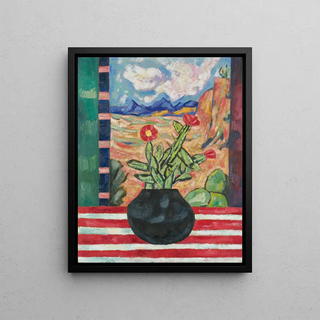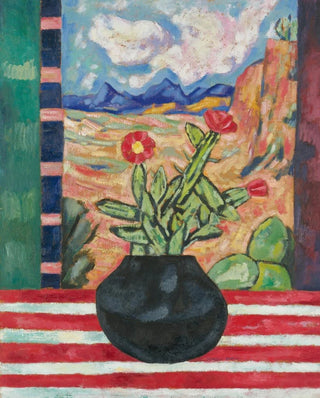Art print | Untitled Still Life - Marsden Hartley


View from behind

Frame (optional)
In the vibrant universe of modern art, certain artworks stand out for their ability to evoke deep emotions and capture the very essence of life. "Untitled Still Life" by Marsden Hartley is one of those creations that, through its apparent simplicity, reveals a fascinating complexity. This piece, although lacking an explicit title, invites the viewer to immerse themselves in a world of vibrant colors and delicate forms. Hartley, an iconic figure of American modernism, manages to transcend traditional still life boundaries to offer a unique visual experience, where each element seems imbued with meaning and history.
Style and uniqueness of the work
Hartley's work is characterized by a bold style and a rich color palette that captivate the eye. In "Untitled Still Life," the artist merges organic and geometric shapes, creating a harmonious dialogue between abstraction and figuration. The colors, ranging from earthy tones to bright hues, evoke a sense of warmth and closeness. Every brushstroke appears to be a declaration, an invitation to contemplate the beauty of everyday objects. Hartley does not merely depict objects; he elevates them to an almost spiritual level, suggesting that even the most ordinary elements can become sources of inspiration and reflection. This innovative approach makes his work a centerpiece, where the still life becomes a true tableau of life.
The artist and his influence
Marsden Hartley, born in 1877 in Maine, is often regarded as one of the pioneers of American modern art. His artistic journey is marked by diverse influences, from Post-Impressionism to Expressionism. Hartley skillfully integrated these currents while developing his own voice, characterized by a unique sensitivity to nature and human emotion. His work was deeply influenced by his travels in Europe, where he met artists such as Pablo Picasso and Henri Matisse. These exchanges enriched his artistic vision and encouraged him to explore new techniques and concepts. By reinterpreting the still life, he created a visual language that continues to inspire many contemporary artists.

Matte finish

View from behind

Frame (optional)
In the vibrant universe of modern art, certain artworks stand out for their ability to evoke deep emotions and capture the very essence of life. "Untitled Still Life" by Marsden Hartley is one of those creations that, through its apparent simplicity, reveals a fascinating complexity. This piece, although lacking an explicit title, invites the viewer to immerse themselves in a world of vibrant colors and delicate forms. Hartley, an iconic figure of American modernism, manages to transcend traditional still life boundaries to offer a unique visual experience, where each element seems imbued with meaning and history.
Style and uniqueness of the work
Hartley's work is characterized by a bold style and a rich color palette that captivate the eye. In "Untitled Still Life," the artist merges organic and geometric shapes, creating a harmonious dialogue between abstraction and figuration. The colors, ranging from earthy tones to bright hues, evoke a sense of warmth and closeness. Every brushstroke appears to be a declaration, an invitation to contemplate the beauty of everyday objects. Hartley does not merely depict objects; he elevates them to an almost spiritual level, suggesting that even the most ordinary elements can become sources of inspiration and reflection. This innovative approach makes his work a centerpiece, where the still life becomes a true tableau of life.
The artist and his influence
Marsden Hartley, born in 1877 in Maine, is often regarded as one of the pioneers of American modern art. His artistic journey is marked by diverse influences, from Post-Impressionism to Expressionism. Hartley skillfully integrated these currents while developing his own voice, characterized by a unique sensitivity to nature and human emotion. His work was deeply influenced by his travels in Europe, where he met artists such as Pablo Picasso and Henri Matisse. These exchanges enriched his artistic vision and encouraged him to explore new techniques and concepts. By reinterpreting the still life, he created a visual language that continues to inspire many contemporary artists.






